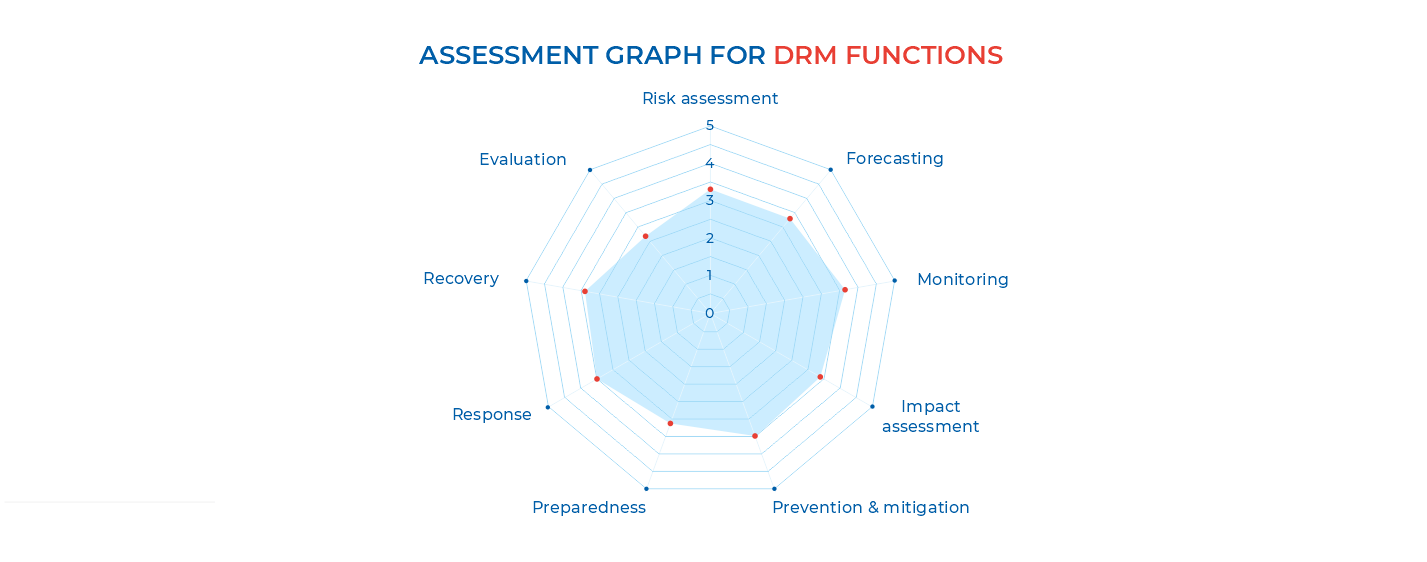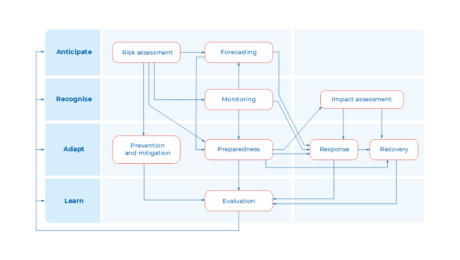
THE 2ND AHA CENTRE INFORMATION MANAGEMENT NETWORK (AIM-NET) MEETING AND WORKSHOP
On 12-14 September 2022, the ASEAN Coordinating Centre for Humanitarian Assistance on disaster management (AHA Centre) organised the 2nd Meeting and Workshop of the AHA Centre Information Management Network (AIM-Net) in Jakarta, Indonesia. Twenty-three (23) representatives of the National Disaster Management Offices (NDMOs) of the ASEAN Member States (AMS) took part in the workshop, which was facilitated by the AHA Centre, Leveraging ASEAN Capacities for Emergency Response (LACER) Project, and Pacific Disaster Center (PDC).
Following up on the 1st AIM-Net Meeting held in February 2021, the 2nd AIM-Net Meeting and Workshop aimed to review the prioritised objectives of the AIM-Net Work Plan, familiarise participants with the AHA Centre Work Plan and the ICT Roadmap and their connection with the AIM-Net Work Plan, and finalise the AIM-Net Work Plan 2025 for Disaster Information Management (DIM) and Information Systems Interoperability (ISI).
AIM-Net is supported by the European Union through the EU-ASEAN Integrated Programme in Enhancing the Capacity of AHA Centre and ASEAN Emergency Response Mechanisms, known as EU-SAHA.
Representing the European Union Mission to ASEAN, Program Manager for Climate Change, Mr. Muammar Vebry, conveyed his optimism that the workshop could serve as a platform to coordinate and strengthen Disaster Information Management capabilities and Information Systems Interoperability between the ASEAN Member States, and strengthen the ties between the EU and ASEAN. “EU-SAHA, in a way, has managed to bring our two regions closer – conceptually, in terms of our approach, and in terms of our collaboration,“ he added.
At the meeting’s opening session, Executive Director of the AHA Centre Mr. Lee Yam Ming highlighted the importance of information management in disaster response. “Data and information are the bases of decisions that enable effective and efficient disaster management and facilitate appropriate and timely emergency response,” said Mr. Yam Ming. “In order to ensure well-informed and prompt decision-making, such data and information must be available, of quality, and accessible.”
However, among the ASEAN NDMOs there is a wide spectrum of technical capacities and capabilities on Disaster Information Management (DIM) and Information Systems Interoperability (ISI). Hence, ensuring the availability, quality, and accessibility of core datasets for disaster management and emergency response remains a challenge for ASEAN.
Against this backdrop, the AIM-Net was established to be a regional forum where the Emergency Operations Centres (EOCs) of NDMOs and the AHA Centre can coordinate and cooperate in strengthening capacities, capabilities, and practices on Disaster Information Management and Information Systems Interoperability.
“There is definitely homework to create and ensure the sustainability of disaster information management in our beloved ASEAN region,” said Dr. Raditya Jati, Deputy Minister of System and Strategy of the National Disaster Management Authority of Indonesia (Badan Nasional Penanggulangan Bencana – BNPB) and AIM-Net Co-Chair, “and that homework is to accomplish better together as One Community, One ASEAN, and One Response.”
During the workshop, AIM-Net Focal Points worked on refining the Network’s Work Plan, including its objectives, list of activities, timeline, and resources required, both in Disaster Information Management and Information Systems Interoperability. From this point, the AHA Centre will consolidate all inputs, refine the draft, and finally circulate the Work Plan to the ASEAN Committee for Disaster Management (ACDM) for finalisation and approval.
The workshop also marked the end of Indonesia and the Philippines’ Co-Chairmanship of AIM-Net, who had successfully led the Network through the 1st and 2nd AIM-Net Meetings and left the Network with the legacy of the AIM-Net Terms of Reference (ToR), ASEAN Disaster Information Management Strategic Framework, and the AIM-Net Work Plan. The Singapore Civil Defense Force (SCDF) and NDMO Lao PDR will now assume leadership of AIM-Net until 2023.
Mrs. Deniece Krizia Manding-Ballesteros, AIM-Net Co-Chair from the Philippines National Risk Reduction and Management Council – Office of Civil Defense (NDRRMC-OCD), commended the participants for the fruitful workshop and expressed her hopes for the future of AIM-Net. “With the success of this activity, I hope we will keep the same energy, commitment, enthusiasm, and level of participation for the next activities of AIM-Net until 2025 or further. I have confidence that the next AIM-Net co-chairs, NDMO Lao PDR and SCDF Singapore will guide the network for the realisation of these goals and activities,” she said.
The three-day event concluded with a visit to the Emergency Operations Centres (EOCs) of BNPB and the AHA Centre, which facilitated the sharing of knowledge and experience in disaster information management. The 3rd AIM-Net Meeting is targeted to be held in 2023, and will include a workshop on DIM and ISI, training needs assessment, and study visit of the host country’s EOC.

Written by: Gladys Respati | Photo credit: AHA Centre

LACER INTRODUCES A STRATEGIC TOOL FOR ENHANCING DISASTER MANAGEMENT IN THE AHA CENTRE AND BEYOND
The EU-funded LACER project aims to sharpen procedures for strategic planning and programming in ASEAN´s disaster management capacities. The disaster risk management (DRM) tool used by LACER is intended to support the elaboration of plans for capacity development projects and to assess the strengths and weaknesses of DRM systems in any part of the world. Peter Månsson, after obtaining a PhD in disaster risk management, was recruited to the project in 2021, bringing with him the methodology originally developed at Lund University and subsequently adopted by the Swedish Civil Contingencies Agency (MSB).
Aside from assessing the disaster management capacities of the AHA Centre, the tool can support the mapping of external support and the existing institutional framework. Moreover, it may be used for assessing and comparing disaster management capabilities of ASEAN Member States. Such an overview would enable the AHA Centre to guide the Member States toward developing specific disaster management abilities. This would not only benefit members but allow the AHA Centre to play a pivotal role as a mediator of cross-border collaboration and peer-to-peer learning, while strengthening disaster management capabilities across the region.
Figure 1. Key functions of DRM-systems and some of their interdependencies

Protecting human values and learning from disasters
The DRM tool is a refinement of a method for assessing community resilience, which further builds on an established theory of resilience engineering and the four cornerstones of resilience.1
The purpose of DRM systems is to protect what human beings value and, to achieve that, the systems need to anticipate, recognize, adapt to and learn from disasters and other types of disturbances to societal safety. DRM systems need to be able to perform a set of functions where anticipation is ensured through the functions of risk assessment and forecasting. To recognize when disasters are about to occur, or have happened, we need the functions of monitoring and impact assessments. To adapt societies to safeguard what humans value, we utilize the proactive functions of prevention/mitigation and preparedness as well as the reactive functions of response and recovery. Finally, to continuously learn and develop safer societies, we need the function of evaluation to enhance the impact of DRM systems.
These functions are not only vital in themselves, but also dependent on each other in such a way that the performance of one function requires the output from another function, e.g. to warn the public to take shelter against a coming cyclone necessitates information from forecasting or weather monitoring.
Figure 3. Column type graphs are useful for comparing various organizations and realize who may learn from whom relative to these functions.

Using the tool for capacity assessments
While these functions are general for all DRM systems in the world, the specifics of how they are implemented, by who and with what resources vary greatly from country to country. Assessing the capacity to perform each function in a specific country entails analyzing what actually exists in that context in order for each function to work. To do this in the ASEAN context, the LACER project developed a survey that contains a number of statements related to these factors, which need to be assessed for each function for a comprehensive analysis of capacities of the DRM system. The results of the survey may be visualized with the help of a “spider graph”, which shows where the prerequisites for performing the functions are adequate or may be improved (Fig. 2). The traceability of the tool enables the user to identify which aspects are judged to be substandard and need to be developed in order to enhance the performance of a specific function.
In addition, the tool may be used to compare assessments of different organizations with each other. For example, assessments of various national disaster management organizations (NDMOs) may reveal who can learn from others regarding a specific DRM function. Such an overview could provide the AHA Centre a means for instigating and facilitating cross-border collaboration in support of proactive disaster management to the benefit of the region at large.
Yet, graphs of ten different NDMOs would make a spider chart cluttered and the information hard to distinguish. Hence, for comparisons across organizations it is better to use one chart per function and bar graphs, where the NDMOs are shown as different columns on the x-axis and their capabilities on the y-axis (see Fig. 3).
Figure 3. Column type graphs are useful for comparing various organizations and realize who may learn from whom relative to these functions.

Using the tool for mapping institutional frameworks and donor support
During the fall of 2021, the tool was used by the LACER project for two additional purposes: to attain overviews of 1) the institutional framework of the AHA Centre and 2) the support it receives from external partners.
In the first case, legislative requirements, guidelines and standard operating procedures of the AHA Centre and the EU Civil Protection Mechanism were compared. In the latter case, the tool was used to analyze all support received by the AHA Centre from external agencies and donors, by looking through the lens of capability for each function.
Importantly, the AHA Centre receives support from 31 external agencies. The results, however, suggest that external support is unevenly distributed over the functions, with certain functions such as Preparedness, Response and Recovery receiving the lion´s share of support and interest from external funders whilst other functions such as forecasting and impact assessment receive little attention. Since the nine general functions are mutually dependent, it makes sense for a DRM organization pursuing a balanced approach in terms of institutional frameworks and support from external partners. Depending on the outputs of capacity assessments, an organization may opt to seek greater external support for some particular functions. Such imbalances, however, should be based on thorough assessments and conscious strategic decisions rather than ad hoc opportunities for funding.
Having a sound understanding of one’s own deficiencies and development needs shows strategic depth and indicates the presence of a serious partner that has a clear idea about which capabilities need to be addressed to become an even stronger player in the field of disaster management. The tool described here is a means to this end.

1 The theoretical basis of the tool is described in Becker, P., Abrahamsson, M., & Tehler, H. (2014). An emergent means to assurgent ends: Societal resilience for safety and sustainability. In C. P. Nemeth, & E. Hollnagel (Eds.), Resilience Engineering in Practice, Volume 2: Becoming Resilient (pp. 1-12). Boca Raton: CRC Press.
Written by: Dr. Peter Månsson, LACER Organisational Development Expert.

MONTHLY DISASTER REVIEW AND OUTLOOK
SEPTEMBER 2022 | DISASTER MONITORING & ANALYSIS
(DMA) UNIT, AHA CENTRE
GENERAL REVIEW OF SEPTEMBER 2022
For the month of September 2022, a total of 193 disasters or a daily average of 6 disasters were reported. Compared to the previous month (August), this is more than twice as many and 1.5x higher compared to September of the previous year. This is also 3.4x higher than the five-year average (2017-2021) of disaster occurrences for the month of September. September 2022 saw disasters affecting 596 per 100,000 people* and internally displacing 10 per 100,000 people*. From the start of the year 2022, a total of 11.6M persons have been affected by disasters or an average of 42,591 persons in a day. This total is already 1.2M or 11% higher than the same period of the previous year.
The ASEAN Member States that were affected are Cambodia, Indonesia, Malaysia, the Philippines, Thailand, and Viet Nam. Most of the disasters (68%) occurred in Indonesia but only accounted for 8% of the total reported affected persons for September 2022. Thailand, despite accounting for only 6% of the disaster occurrences for the month, accounted for 73% (2,916,745) of the total reported affected persons for the month. On one hand, the share of disaster occurrences for the other member states are as follows: Cambodia – 3%, Malaysia – 3%, The Philippines 8%, and Viet Nam – 10%. On the other hand, the share of affected persons for the other member states are as follows: Cambodia – 0.001%, Malaysia – 0.0004%, the Philippines – 37%, and Viet Nam – 1.6%.
Most of the disasters that have occurred in September 2022 are floods (63%) and is consistently the most recorded disaster-causing natural hazard for September of the previous year and September on a five-year average (2017-2021). The reported disasters in the region for September 2022 in comparison to the historical data (average for September 2017-2021) indicates that there were about 3.4x more reported disasters; 1.08x less people affected; 2.4x less people internally displaced; 9.8x more houses affected to some extent; 8.5x less lives lost; 12x less people suffering injuries; and lastly, 28x less people that have gone missing. The main drivers of the impacts in the ASEAN region were the monsoon situation in Thailand that have caused widespread flooding as reported by the Department of Disaster Prevention and Mitigation (DDPM) and the impacts of Tropical Cyclone (TC) NORU in the Philippines, Viet Nam, Lao PDR, Cambodia, and Thailand. The tropical cyclone affected multiple member states, but the Philippines’ resources were sufficient, and Viet Nam was able to prepare well. Thailand had requested for relief items in response to TC NORU-associated flooding which has worsened the situation in areas that have long been impacted by the monsoon situation.
Geophysically, 43 significant earthquakes (Magnitude ≥ 5.0) were reported by Indonesia’s Badan Meteorologi, Klimatologi dan Geofisika (BMKG), the Philippine Institute for Volcanology and Seismology (PHIVOLCS), the Thai Meteorological Department (TMD), and the Department of Meteorology and Hydrology (DMH) of Myanmar. This emphasizes the importance of disaster preparedness as three ASEAN Member States lie on the “Pacific Ring of Fire,” a zone of active volcanoes and frequent earthquakes.
Mount Semeru, Ili Lewotolok (Alert Level III), and Ibu, Dukono (Alert Level II) in Indonesia and Taal Volcano (lowered to Alert Level 1), Mayon, Mount Kanlaon (Alert Level 1) were reportedly tectonically active (erupting lava or releasing gas or generating seismic activity) throughout the whole of September 2022.
*Computed based on 2020 population data from worldometers.com
SEASONAL OUTLOOK
For the month of September 2022, much of the ASEAN region experienced rainfall more than what is traditionally experienced for the month. Wetter conditions (compared to the average for September 2022) were recorded over Viet Nam and Southern Borneo hence the hydrometeorological-induced disasters in Viet Nam and Indonesia. In contrast, below-average to average rainfall were recorded in Peninsular Malaysia, the Philippines, and Northern Myanmar, northern Lao PDR, northern Sumatra and northern Papua of Indonesia. Despite this, hdyrometeorological hazard-induced disasters still occurred in most of these areas (except northern Myanmar, northern Lao PDR, and northern Papua).
According to the ASEAN Specialised Meteorological Centre (ASMC), for the October-November-December period much of the ASEAN region will be experiencing above-normal rainfall. Normally, this period is regarded as the disaster season for the region. This is on top of the traditionally wet monsoon seasons in Thailand (May-October), Cambodia (May-October), Lao PDR (May-October), Viet Nam (May-November), the typhoon season in the Philippines (July-October) and the start of the rainy season in Indonesia (November-March). Therefore, the threat of hdyrometeorological hazard-induced disasters is even more likely.
In terms of temperature, below- to near-normal temperatures are favoured for parts of the equatorial region and much of the Mainland Southeast Asia, with above-normal temperature favoured elsewhere which likely means for hotspot activities to generally be subdued for the period.
The qualitative outlook is assessed for the region in general. For specific updates on the national scale, the relevant ASEAN National Meteorological and Hydrological Services should be consulted. More outlook and verification plots, including for tercile and quintile probabilistic forecasts for temperature, are in the “Model products and verification: NCEP, ECMWF, UK Met Office” on the SEA-RCC Network LRF Node webpages.
Sources: ASEAN Disaster Information Network (ADINet), ASEAN Disaster Monitoring and Response System (DMRS), ASEAN Specialised Meteorological Centre (ASMC), Badan Nasional Penanggulangan Bencana (BNPB) – Indonesia, Agensi Pengurusan Bencana Negara (NADMA) – Malaysia, National Disaster Risk Reduction and Management Council (NDRRMC) – Philippines, Department of Disaster Prevention and Mitigation (DDPM) – Thailand, Thai Meteorological Department (TMD) – TMD, Viet Nam Disaster Management Authority (VNDMA) – Viet Nam, Badan Meteorologi, Klimatologi dan Geofisika (BMKG) – Indonesia, Pusat Vulkanologi dan Mitigasi Bencana Geologi (PVMBG) – Indonesia, Department of Meteorology and Hydrology (DMH) – Myanmar, Philippine Institute for Volcanology and Seismology (PHIVOLCS) – Philippines, Philippine Atmospheric Geophysical and Astronomical Services Administration (PAGASA) – Philippines
Written by : Keith Paolo Landicho, Sadhu Zukhruf Janottama, Lawrence Anthony Dimailig
DISCLAIMER
The AHA Centre’s estimation is based on data and information shared by National Disaster Management Organisations (NDMOs) and other relevant agencies from ASEAN Member States, international organisations, and news agencies. Further information on each recorded significant disaster, description, and detail of data and information are available at: http://adinet.ahacentre.org/reports.

ADDM & IDDRR 2022:
SYNERGISING REGIONAL AND GLOBAL ACTION FOR DISASTER RESILIENCES
Every year, disasters triggered by natural and non-natural hazards affect millions of people globally. As one of the most disaster-prone regions in the world, ASEAN is particularly vulnerable. From 2015 to 2021, 104.2 million people1, or about one in four people in the region, were affected by disasters. Meanwhile, the total economic loss suffered by ASEAN Member States during this period reached a staggering US$11.1 billion.
However, the impact of these disasters can be lessened through systematic efforts to identify, assess, and reduce the causal factors of disasters. This is known as Disaster Risk Reduction or DRR in short. Disaster Risk Reduction itself is part of Disaster Management, which the United Nations Office for Disaster Risk Reduction (UNDRR) defines as “the organisation, planning and application of measures preparing for, responding to and recovering from disasters2.”
The complexity of disasters and their wide-ranging effects mean that the cooperation of multiple stakeholders is vital to disaster management. Over the years, ASEAN and the AHA Centre have had the privilege of partnering with a wide range of governments, institutions, and organisations. These partnerships have played valuable roles, ranging from direct financial support, bringing in skilled professionals to provide key technical inputs, to partnerships based on knowledge sharing and capacity building.
To sustain these partnerships and enhance awareness of national and regional activities related to disaster management and risk reduction, the ASEAN Ministers responsible for disaster management designated 13 October as the ASEAN Day for Disaster Management (ADDM), which is observed jointly with the UN’s International Day for Disaster Risk Reduction (IDDRR).
This year’s ADDM celebration took place on 20 October in Bangkok at the margins of the 11th ASEAN Ministerial Meeting on Disaster Management (AMMDM) and 10th COP to AADMER. The theme of ADDM 2022, “Stronger Together in Balancing Action to Enhance Localisation for Disaster Resilience,” dovetails with target G of the Sendai Framework that aims to increase access to multi-hazard early warning systems and disaster risk information and assessments to people.
In his remarks, AMMDM Chair General Anupong Paochinda emphasised that “the themes of ADDM and IDDRR this year call for collaboration and support from all sectors in making our local communities resilient by equipping them with disaster risk information, early warning system, and means of disaster preparedness.’’
The AHA Centre supports ASEAN Member States in this endeavour through one of its core functions, namely disaster information management. Utilising the ASEAN Disaster Monitoring and Response System (DMRS), the Centre works with Member States to monitor hazards, collect, analyse, and disseminate key relevant information to support disaster management.
The AHA Centre also disseminates information on a regular basis to the public, through Flash Updates and Situation Updates during emergency times, as well as Weekly Disaster Updates and the Monthly Disaster Outlook and Review in non-emergency times. Additionally, in May 2022, ASEAN launched the Framework on Anticipatory Action in disaster management, that will guides the ASEAN Member States in implementing anticipatory action in disaster risk management (DRM) at the regional, national, and local scale through joint regional efforts.
To become a truly disaster-resilient region, going forward, it will become increasingly important for ASEAN and its partners to synergise regional and global efforts in disaster management that not only target institutions, but also communities and individuals at the local level.
1 Based on ADINet records from reports from NDMOs and official information sources.
2 https://www.undrr.org/terminology/disaster-management
Written by: Gladys Respati | Photo credits: DDPM Thailand, AHA Centre















